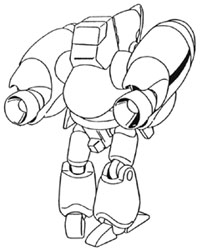

Designation:Space Defense Robot SDR-10 Mk II Shark |

|
||||

|
|||||
| Total Height: | 8.7m |
| Total Depth: | 4.9m |
| Total Breadth: | 5.4m |
| Weight: | 16.2 metric tons (dry) |
| 37.1 metric tons (fully loaded). |

Each bin can hold:
The armor on the Shark is a new development in low-mass composite-materials Chobham plating that became the standard for all Terran mecha after its application to the VQ-6A Vandal. Aside from the respectable protection provided against projectiles, missiles, and other kinetic weapons, this armor is also resistant to plasma globes (annihilation discs), lasers, and to a lesser extent, particle guns, owing to the fact that the armor can flake off and evaporate in layers under fire from such high-energy weapons, taking much of the weapon's energy and converting it into the latent heat of sublimation in the armor. The armor stops all small arms, heavy infantry weapons fire, and light mecha-mounted weaponry, and provides good resistance to medium mecha-mounted weaponry, such as the Valkyrie's 55mm APFSDS round, and poor resistance to heavy mecha-mounted weaponry, such as the VHT's 120mm smoothbore shells.
The Shark provides full protection from nuclear, biological, and chemical hazards, using an overpressure cockpit environment activated by radiation and hazardous chemical sensors, or manually when biological warfare conditions are anticipated. The internal consumables supplies can provide atmosphere for three days maximum.
The prime fault of the Phalanx Destroids was their nonexistent battlefield performance. These mecha, with their missiles' range of 70 km, were no match on the battlefield because of their lack of direct fire weapons. Because of this, the Phalanx was mostly used in the second line, where they could fire on the Zentraedi without immediately becoming targets for the battle pods. This also meant that battlefield fire from a Phalanx battery had to be called in by forward observers and had an arrival time that could run into minutes. With the fast developing situation on a Robotech battlefield, this was just too slow. The REF therefore developed the Shark, which entered service in 2022. This mecha was still not intended for the battle-line, but it could, because of its armament, be stationed far closer to the fighting than its UNDF equivalent. If the battle would engulf the Shark, the mecha could use its enhanced speed to evade the enemy, meanwhile elevating the particle beam out of its protective covering, and keeping hostiles at a distance with it.
The enhanced performance was not without cost, however. The additional direct fire weapon, the higher speed and the reduced size decreased the missile load to a mere seven Derringers per bin, whereas the Phalanx could carry 22. On the other hand, the bins could alternatively adapted to carry 30 Diamondback MRMs each, and most Sharks went into the field with one bin loaded with Diamondbacks and the other with Derringers. Because of this combined air/ground MRM/LRM capability, and the increased response time of the new version more than compensated for this, and the Shark was used, with its fellow Destroids, on every front where the REF fought.
Return to REF Index
Return to Robotech Reference Guide Home Page.
Robotech (R) is the property of Harmony Gold. This document is in no way intended to infringe upon their rights.
Content by Peter Walker and Pieter Thomassen, with Rob Morgenstern
Copyright © 1997, 1995 Robert Morgenstern, Peter Walker, Pieter Thomassen
Last Updated: Thursday, November 20, 1997 4:31 PM